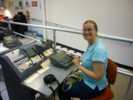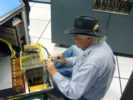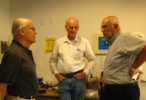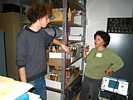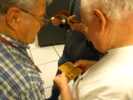Schedule August 2008
return to main 1401 Restoration Page
go to Team Bios
Contents:
Saturday August 02; Good News - CHM tours; Bad News - 1401 Tour Readiness
Techniques for increasing electronic reliability - Added August 9, 2008
These techniques were also used by General Electric Computer Department field people (and folks in other companies and services)
to minimize electronic logic failures.
I claim we made (or could make) electronic logic failures about as low as IBM. (But non-IBM companies generally did not provide such easy to use tools.)
If we had had good peripherals available, we would have given IBM a much better run for the money :-))
Wed August 6 - General
Wed August 13 - general
Wed August 20 - General
Our problem is now worse as Tim Coslet is now in Montana, along with his
three point in-circuit testor. We currently have no
effective way of fixing suspect/defective cards.
Matthais suggested that maybe we design something which just looks for gross defects - open, short -
Ron Williams said that those problems are relatively easy to trouble shoot - the difficult trouble comes when say a transistor
is leaking too much and causes a "base line drift". or a weak transistor barely able to drive the required load,
or a slow transistor - border-line stuff -
(The various IBM specified margin tests
(1.1 metabyte file) help turn border-line cases into solid error cases during the margins, making much easier trouble shooting
- and help get borderline cards out of the system.)
To make reliable hardware capable of testing for the many variables is daunting -
To make a bad problem even worse, there seemed very little restraint on issueing new SMS card types.
I did an analysis of card usage in the DE 1401 and 1406 which showed
"The 1401 processor has about 2912 SMS cards of about 223 SMS card types, ... "
To make a data base to effectively test the various circuits (including storage elements - flip-flops) for this
number of unique cards seems doubly daunting. :-((
Frank King and Ron Williams publicly state that when a "repaired" card - or "no fault found" card came back from the repair center,
and didn't work, that card usually had a fatal "accident" - like getting broken -. Others just nodded knowingly.
Thurs August 21 - tape team
Robert Garner responded
I like your tape emulator proposals - thanks for taking this on!
Being able to emulate up to 6 tape drives (while including our operational 729) will enable us to run the full complement of 1401 binaries we now have (before more of the 729's are running.)
Re: Which task is higher priority: Getting the CT 1401 TAU up and running with your Tape Emulator is highest priority.
Re: Your proposal for making available Fortran, Sort/merge, Autocoder, BigPrint, and a utility library via the Tape Emulator is fantastic!
Of course, once the CT 1401 is up, your Tape Emulator can be used there too.
For the wireless network and IP address, contact Khanh Tran or Vinh Quach. (I've cc'd Vinh on this msg.)
- Robert
p.s. Our recently acquired Fortran, Cobol, Autocoder, etc binaries that Paul Pierce read for us are located here:
http://www.piercefuller.com/library/ibm1401.html
I can resend Paul's emails describing the formats, etc, if you don't still have them in your inbox.
Ed ---> Have we copied these images to our web site? Thx!
Sat August 23 - 4th Saturday
Wed August 27 - general
Thurs August 28 - tape team
We started working on the new 1401's TAU last Thursday. Our first
objective was to fix the bugs that were preventing the TAU from
reseting. (When reset, all indicator lights on the TAU control panel
should be off. Two were on.)
The first thing that we noticed was that there were a lot of yellow
wires on the TAU backplanes. This indicates that many engineering
changes were applied to this machine while it was in the field. The
second thing that we noticed is that _*the TAU logic in the vicinity of
the first bug did not match the ALD documentation!!!*_
When we copied the TAU ALDs we found changes to about 6 pages. From the
number of yellow wires, the changes are much greater than that. _*The
TAU is at an engineering change level somewhere between its
documentation and the German system.*_
We were able to use the German ALDs to trouble shoot the first bug. The
Conn. systems ALDs were able to be used for the rest of the work
Thursday. However, the documentation gap may could become a show-stopper
down the road.
*Status:*
Next Week:
Regards,
Saturday August 02 - failed demo, Techniques for increasing electronic reliability
Wed August 06 - general,
Wed August 13 - general,
planned visit by Jim Ingram
Wed August 20 - general, Thurs August 21 - tape team
Sat August 23 - 4th Saturday
Wed August 27 - general, Thurs August 28 - tape team
An e-mail friend, Charles OHearn, and his wife came to town.
He had worked Nike systems and then commercial computers for many years
so of course I had to show him CHM Saturday August 2nd :-))
--------- Good News - CHM tours ---------
At 12:00 we took the Short Visible Storage Tour,
which was just fine :-))
Very well done - Museum can be proud :-))
At 1:00 we watched the Babbage Demo, nice crowd -
Judith Haemmerle lectured, she is good!!
and John turned, one jam -
We were informed how lucky we were to see a jam,
while John cleared it ;-))
The museum, Doron Swade and Tim Robinson can be proud.
http://www.ed-thelen.org/BabInstCHM/index.html#Visit
We then went to see the PDP-1 demo -
again smoooth ;-)) fun :-))
Folks were impressed with first person comments
by the docents -
--------- Bad News - 1401 Tour Readiness ---------
Then I took my guests to see the 1401 -
I fired up the 50 Hz converter and the DE system.
Then I key punched a date card and two name cards,
and tried to run the BIGPRINT deck.
First try it got a read check after about 8 cards,
tried again - maybe 5 cards
tried again - maybe 13 cards.
So I gave my friends the name cards as souvenirs
and we left to talk for an hour or so
at a table in the Chess Exhibit.
I watched Stan have a seemingly similar situation several weeks ago.
- with about 20 guests -
The DE 1401 system still has "morning sickness",
not much better than
http://www.ed-thelen.org/1401Project/Sched2007February.html#26
The machine has to be energized for several hours
before probably working properly -
--------- Tirade ---------
(stuff deleted)
And in civilian life, morning sickness is an indication
of unacceptable reliability - no face if nothing else.
Your very automobile
- if it backfires and smokes for the first 15 minutes
- guess what - you get the mechanic to fix it.
Maintenance to get reliable cold starts is not rocket science.
Whole generations of military and civilian folks have figured
how to do it.
--Ed Thelen
The following 5 pages (about 1.1 megabyte) is from IBM Field Engineering Maintenance Manual
1401 Data Processing System 225-6487-3
(re-sized from Paul Pierce's web site, Thank You - about 7 megabytes) that deal specifically with increasing
the reliability of the IBM 1401 - the procedures are listed as Scheduled Maintenance. These procedures have yet been
used on our 1401s.
PPierce-IBM-225-6487-3-MarginalChecking.pdf, Marginal Checking (MC) (1.1 megabyte file)
Report by Robert Garner - most of core memory repair section by Judith Haemmerle
Other current photos
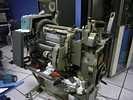
CT1403tearDown
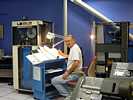
Allen729sModVs
Bob's not waving his hands in a magical incantation; he's positioning the .0071 wire, holding it in both hands and working it back and forth.
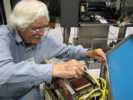
Teasing up the broken wire
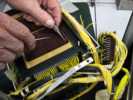
Tinning one end of the broken wire. You can see smoke rising from the soldering iron.
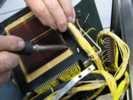
The new wire threaded through the frame - you can see it lying across the cores. It's a different color because of the insulation on the new wire.
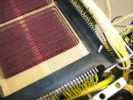
With
Judith Haemmerle, went thru remaining CT boxes and dispersed items to 1401 room
or to warehouse. Most boxes have been emptied. (Thanks to Judith
for managing our little depo of CT boxes over the past several months
and organizing copying of ALDs and manuals! See helps to keeps us
honest and moving forward.)
Ron Williams (left) and Bob Erickson bug shooting the CT 1406. They suspect that a slipping probe induced
this problem - like it slipped, and a power supply tripped.
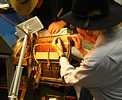
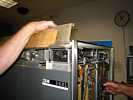
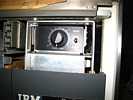

Bill Flora found this swollen capacitor in the Voltage Margin Power Supply, located under the card punch section
of the 1402
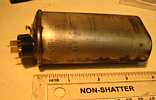
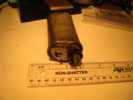
The capacitor is used by the ferroresonant transformer.
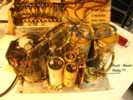
- Mov characters in storage until word mark
- Unconditional Jump back to the Mov instruction,
But the above loop seems to be working correctly :-))
Sound simple enough for a math major? - right - except -
I suppose when "we" find a defective "CR" card we will have to search for a replacement that at least has the same
component count and looks the same - . Maybe best we didn't shoot the messenger ;-))
Not included are cards unique to 729 tape drives.
From Bob Feretich
Jeff and I made plans to start working at the CHM on Thursdays again.
We have two projects in mind.
The German System:
We would like to set up the Tape Drive Emulator for docent and class
use. We thought it appropriate to accomplish this by enabling the
system to perform some classic 1401 program that required the use of
multiple tape drives. Once we get the Fortran compiler up, it should be
easy for other multi-tape programs like Autocoder or Sort/Merge to run.
We would like to set up the emulator to communicate via Wi-Fi to the
user's notebook computer. Do we need to get any CHM IT people involved
to do this? Usually IT managers get upset when they are surprised by
unauthorized networks operating in their buildings.
This project requires the assignment of an IP address to the emulator.
Will the CHM IT department provide us with one, or should we get one on
our own?
We also want to create a virtual tape library. The tape library would
be accessible to any Emulator user. It would initially contain utility
programs like:
Of course, we also would put the Fortran compiler into this library .
Is there anyone at the museum who is interested in expanding this
library concept to include the demonstration programs, like BigPrint?
We can show them how to add programs to and manage the library. Writing
demo programs would be much easier. Executable files are created
directly from the Rope cross-development tools. ASCII to/from BCD
conversions for data files is already built into the Emulator.
The Connecticut System:
Once Ron and Bob put the 1406 back together, Jeff and I could start
bringing up the TAU unit.
Which of the two projects should receive priority?
Regards,
Bob
Bob,
There was activity - I took vacation from web site
From Bob Feretich
TAU Debug Status - Thursday, August 28th (Jeff & me)
Bob
Go to September 2008
go to Team Bios

